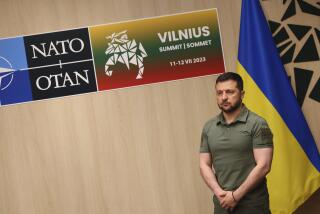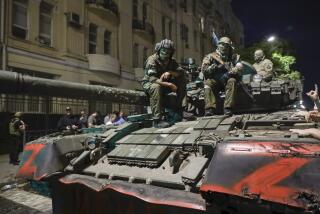Playing for Keeps : THE GREAT GAME: The Struggle for Empire in Central Asia, <i> By Peter Hopkirk (Kodansha: $30; 576 pp., illustrated)</i>
The British called it the Great Game. So did the Russians ( Bolshaya Igra). The ultimate prize was India. Britain had it. Russia wanted it--or so the British feared; something about a secret deathbed command by Peter the Great to his heirs, which may or may not have been given.
The playing field was Central Asia, from the Caspian Sea all the way to Manchu China. In between were some of the most exotic places on the map, or off, places whose existence often was little more than an educated guess, whose names tantalized the tongue and charged the blood:
Urumshi and Turfan, Hami and Osh; the Hindu Kush and the River Ili; the Sacred Mountain of Kailas; Ghazni and Gor; Red Idol Gorge; the Minaret of Death . . .
It was a “vast political no-man’s land,” writes Peter Hopkirk in this slam-bang study. Through the planet’s highest mountain passes and least-forgiving deserts tramped a host of players: ambitious young officers, rapacious traders, flat-out adventurers bound for glory or the gallows, whichever came first.
For a hundred years--culminating in the Convention of 1907--the game, essentially, was Russian thrust and British parry, though occasionally vice versa. Determining who was where, and why, became an obsession for both. Charting terra incognita, particularly putative invasion routes, was indispensable and most often undertaken by a lone traveler of immeasurable bravery, in disguise, and with no assurance of rescue or even recognition once his cover was blown.
Assuming survival, a second task was to line up the support of tribal rulers against the adversary. So isolated were the assorted khanates and kingdoms that the overtures were met with derision. What kind of tribe would be ruled by a queen ? How many camels does this tsar person have?
Meanwhile, alliances made among the Persians, Turks, French, Afghans and Chinese, as well as the British, the Russians and their Central Asian subalterns, were made and broken almost weekly. The entanglements are duly noted by Hopkirk, but “Whenever possible I have tried to tell the story through the individuals . . . who took part in the great imperial struggle.” And so he does:
The Mullah of Gull; the Amban of Sarkand; Umra Khan, the Sultan of Swat; Mir Wali, Chief of the Dards; the Taotai of Kashgar . . .
Despite unparalleled expansion--55 square miles a day for four centuries!--the Russians were driven by paranoia, “an abiding fear of encirclement dating from the invasion of the Mongols and persisting to this day.” The British, on whom the sun never did set in those days, were motivated by a smug sense of manifest destiny, a righteous indignation over any challenge to their global primacy. The real estate of choice was that of the three khanates--Khiva, Bokhara and Khokand. Afghanistan was considered by the British as a buffer state between India and whatever deviltry might be brewing in the north. The khans’ territory was a sort of buffer for the buffer. (The Afghans, as bellicose then as now, knew little and cared less about the Game. Just don’t mess with us , they warned. The British took them up on it, and lost. So, a century later, did the Russians.) Crisscrossing the khanates--as well as the Caucasus and Chinese Turkestan, alternate invasion routes from east and west--was a galaxy of heroes, villains and surpassingly strange wanderers, operating in places that still echo:
. . . Kashgar and Khotan; Dehra Dun and Bozai Gumbaz; the walled citadel of Bala Hissar; Bam-i-Dunya, “the roof of the world”; the lawless Kazakh Steppe; Baroghil and Ishkamin; Hyderabad and Herat; the Taklamakan Desert, which means in Uighur, “Go in . . . and you won’t come out.”
In what Hopkirk calls “a prequel to the Cold War,” forerunners of the MI-5 and KGB match wits and brass with the 19th-Century versions of Khomeini, Ceaucescu, even Amin:
* Safdar Ali, king of funky little Hunza, “nothing but rocks and ice,” deep in the Karakoram Mountains. One of the world’s earlier protection-racketeers, Safdar demanded a subsidy from England for not raiding its caravans, and later pleaded for the return of the captured village of Chalt, “even more precious to us than the strings of our wives’ pyjamas.”
* Arthur Conolly, religious zealot, zealous adventurer and invaluable spy, who escaped from the Karakum Desert with only a wind burn while his bandit captors were arguing whether to rob and kill him or sell him as a slave. Conolly’s favorite disguise was as an itinerant hakeem (doctor): “The simplest medicine will cure most of their ailments, and you may tell those who are beyond your skill that it is not their nusseeb , or fortune, to be cured.”
* Mikhail Skobolev, “The White General” or “Old Bloody Eyes,” who once challenged Bismarck to mortal combat before their two armies. Declaring “(t)he harder you hit them the longer they stay quiet,” Skobolev massacred 15,000 Turkomans at the battle of Geok-Tepe, was hauled from the scene in dishonor, and died at 40 of a heart attack in a whorehouse.
* Henry Pottinger, survivor of his own desert storm in Baluchistan--”Not only could it kill camels with its violence, but it could flay alive an unprotected human being.” Pottinger preferred to masquerade as a wandering holy man, but barely fooled the sharp-witted Urz Begee of Kerman. Asked by a respectful local mullah to offer a prayer of thanksgiving, “I assumed a very grave air, stroked down my beard with all imaginable significance, and muttered a few sentences . . . distinctly pronouncing such words as Allah , Rusool (the Prophet) and Shookr (Thanks) . . . “
* The largely unsung pundits, Indian hill men chosen for their intelligence and resourcefulness to reconnoiter for the British in such secrecy that they were given not names but numbers. They carried daily logs in their prayer wheels; compasses in the wheel’s lids; thermometers, for calculating altitude, in their staves; mercury in cowrie shells, to be poured into begging bowls to set horizons; and used their rosaries to count carefully measured steps.
* The Khan of Khiva, who nailed his Russian slaves’ ears to the wall to prevent escape, and who (according to a German doctor) enjoyed, in addition to his well-stocked harem, “forty or fifty degraded beings. . . “ (One can only guess.)
* Sir Alexander Burnes, who invaded Kabul at the head of a British force that included 30,000 camels, two of which carried nothing but cigars for the officers; Sir William Macnaghten, de facto ruler of Afghanistan after a puppet was installed, whose occupation army enjoyed cricket, polo, drinking and womanizing, and whose wife brought in gowns, wines and crystal chandeliers; Dr. William Brydon, “the messenger of death,” the last of Macnaghten’s sybaritic colonizers: Brydon, with a melon-sized chunk sliced out of his skull, riding a borrowed and grievously wounded pony, his weapons reduced to the haft of a sword (which he threw at his last attacker), stumbled into Jalalabad as the sole survivor of no fewer than 16,000 people driven from Kabul across towering mountains in the dead of winter and then set upon en route by the enraged Muslim Afghans.
. . . Lords Curzon and Auckland, Tsars Alexander and Nicholas, the Sirdar of Nushgi, the Koosh Begee of Bokhara, Shamyl of Daghestan and Babur the Turk and Mahmoud of Ghazni, the Nadir Shah and the Maharajah of Mysore . . .
They all played the Game and they all come to technicolor life in a book that is at once enlightening, informative and energizing, a book whose 600 pages can barely contain its rambunctious cast.
In the end, the Russians were stopped cold, and for good, by a surprise attack on their great naval base of Port Arthur by the Japanese on Feb. 8, 1904. No longer threatened, the British hunkered down in India to practice what they Blimpishly called “masterly inactivity.”
And the spoils of a century of campaigning? “The vast Russian empire has served as a monument to the Tsarist heroes of the Great Game,” writes Hopkirk.
As for Britain’s heroes, “There is little or nothing on the map for all their efforts and sacrifices. Today they live only in unread memoirs . . . “
Until now.


